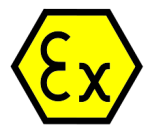La direttiva Atex, abbreviazione di “ATmosphère EXplosible”, si riferisce alla normativa 94/9/CE dell'Unione Europea per la regolamentazione sul mercato dei requisiti di sicurezza per dispositivi, componenti e sistemi di protezione elettrici e meccanici verso il materiale a rischio di esplosione. In particolare certifica i requisiti necessari per aspiratori, turbine e macchinari vari atti a garantirne l'utilizzo in sicurezza in ambienti a rischio esplosioni limitando anche l’utilizzo di prodotti dichiarati pericolosi quali combustibili, solventi, lavorazioni di legno, alluminio e materiali composti.
La normativa prevede l'adozione di sistemi di allarme per la segnalazione di concentrazioni pericolose di gas, polveri, scintille e misure di prevenzione e protezione contro le esplosioni.
La normativa classifica due gruppi di apparecchiature in base alle seguenti categorie:
Apparecchiature per miniere - Gruppo I
- Categoria M1 - Livello di protezione: Molto elevato.
Apparecchiature che possono funzionare anche in presenza di atmosfera esplosiva - Categoria M2 - Livello di protezione: Elevato.
Apparecchiature che devono essere messe fuori tensione in presenza di atmosfera esplosiva
Apparecchiature per superficie - Gruppo II
- Categoria 1 - Livello di protezione: Molto elevato
Presenza di atmosfera esplosiva: sempre, spesso e per lunghi periodi - Categoria 2 - Livello di protezione: Elevato
Presenza di atmosfera esplosiva: probabile - Categoria 3 - Livello di protezione: Normale
Presenza di atmosfera esplosiva: scarsa possibilità e per breve tempo
Nel caso di apparecchiature del gruppo II, viene suddiviso in zone anche il tipo d’atmosfera esplosiva riscontrabile:
GAS, VAPORI E NUBI
- ZONA 0 (presenza continua o frequente di atmosfera esplosiva)
- ZONA 1 (presenza occasionale durante il normale funzionamento di atmosfera esplosiva)
- ZONA 2 (presenza per brevi periodi durante il normale funzionamento di atmosfera esplosiva)
POLVERI
- ZONA 20 (presenza continua o frequente di atmosfera esplosiva)
- ZONA 21 (presenza occasionale per normale funzionamento di atmosfera esplosiva)
- ZONA 22 (presenza per brevi periodi durante il normale funzionamento di atmosfera esplosiva)
+ info su ec.europa.eu (en)
________________
ATEX is the name commonly given to the two European Directives for controlling explosive atmospheres:
It has been mandatory since 1st of July 2003 and concerns risks of injections in explosive atmospheres of equipments that we use in these atmospheres.
Used by countries of EU only, the law classifies the equipments in 2 Groups (and these are divided in categories):
Group I
- Category M1 - Equipment in this category is required to remain functional with an explosive atmosphere present.
- Category M2 - This equipment is intended to be de-energised in the event of an explosive atmosphere forming.
Group II
- Category 1 - Equipment in this category is intended for use in areas in which explosive atmospheres caused by mixtures of air and gases, vapors or mists or by air/dust mixtures are present continuously, for long periods or frequently.
- Category 2 - Equipment in this category is intended for use in areas in which explosive atmospheres caused by gases, vapors, mists or air/dust mixtures are likely to occur.
- Category 3 - Equipment in this category is intended for use in areas in which explosive atmospheres caused by gases, vapors, mists or air/dust mixtures are unlikely to occur or, if they do occur, are likely to do so only infrequently and for a short period only.
ATEX 137 also classifies hazardous areas where an explosive atmosphere could form, by type of hazard, into the following 'Zones'.
Hazard - Gas, Mists or Vapors
- Zone 0 - A place in which an explosive atmosphere consisting of a mixture with air of dangerous substances in the form of gas, vapor or mist is present continuously or for long periods or frequently.
- Zone 1 - A place in which an explosive atmosphere consisting of a mixture with air of dangerous substances in the form of gas, vapor or mist is likely to occur in normal operation occasionally.
- Zone 2 - A place in which an explosive atmosphere consisting of a mixture with air of dangerous substances in the form of gas, vapor or mist is not likely to occur in normal operation but, if it does occur, will persist for a short period only.
Hazard - Dusts
- Zone 20 - A place in which an explosive atmosphere in the form of a cloud of combustible dust in air is present continuously, or for long periods or frequently.
- Zone 21 - A place in which an explosive atmosphere in the form of a cloud of combustible dust in air is likely to occur in normal operation occasionally.
- Zone 22 - A place in which an explosive atmosphere in the form or a cloud of combustible dust in air is not likely to occur in normal operation but, if it does occur, will persist for a short period only.
The Directive applies to electrical and/or mechanical equipment used on the surface, below the ground and on fixed offshore installations. Specifically, the Directive covers:
- All equipment intended for use in potentially explosive atmospheres and which are capable of causing an explosion through their own potential sources of ignition.
- Protective systems intended for use in potentially explosive atmospheres. Protective systems are defined as units which are intended to halt incipient explosions immediately and/or to limit the effective range of explosion flames and explosion pressures.
- Components, which are defined as any item essential to the safe functioning of equipment and protective systems but with no autonomous function.




